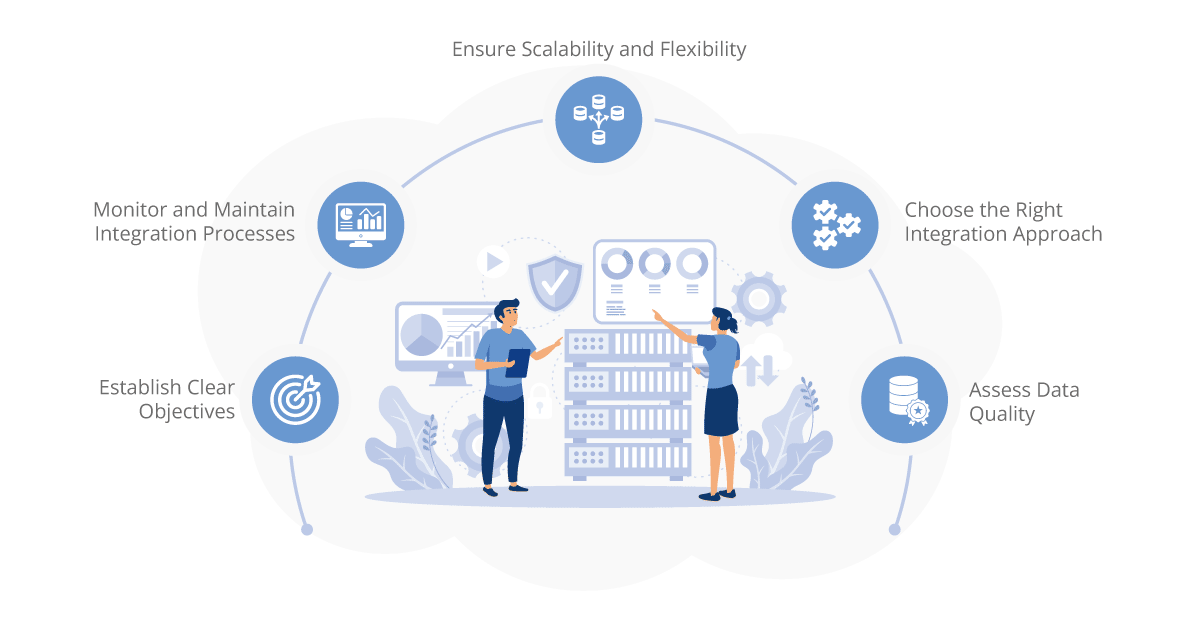Data integration is the process of combining data from various sources into a unified and consistent view, enabling organizations to gain valuable insights and make informed decisions. In today’s data-driven business landscape, where companies generate vast amounts of data, data integration has become a critical aspect of any successful enterprise. However, achieving effective data integration can be challenging due to the complexities of data sources, formats, and integration methods.
Aonflow iPaaS – Free for First 3 Months!
Build and run up to 1,500 transactions monthly with no cost. No payment info needed!
Key Components of Data Integration
Data integration involves three key components: data sources, data transformation, and data delivery.
Data Sources:
Data can come from various sources, including internal databases, external APIs, cloud applications, and third-party data providers. These sources may contain structured data (e.g., databases, spreadsheets) or unstructured data (e.g., emails, social media posts). For example, a retail company may integrate customer data from its CRM system, sales data from its e-commerce platform, and market research data from external sources to gain a comprehensive understanding of customer behavior.
Data Transformation:
Data transformation is the process of converting and preparing data for integration. It includes tasks such as data cleaning, standardization, and enrichment. Data cleaning involves identifying and resolving data quality issues, such as missing values or inconsistencies. Standardization ensures that data from different sources adhere to a common format and naming conventions. Enrichment involves enhancing data with additional information, such as geolocation data or demographic details. For instance, a healthcare organization may transform and enrich patient data from multiple sources to create a unified patient profile for better care coordination.
Data Delivery:
Data can be delivered through various methods, including batch processing, real-time streaming, or a hybrid approach. Batch processing involves collecting data over a period and processing it in scheduled batches. Real-time streaming delivers data immediately as it is generated, allowing near-instantaneous insights and actions. Hybrid approaches combine batch processing and real-time streaming based on specific use cases. For example, an e-commerce company may use batch processing for daily sales reports, while streaming data in real-time for fraud detection.
Best Practices for Data Integration
To ensure successful data integration, organizations should follow these best practices:
Establish Clear Objectives:
Define clear business goals and requirements for data integration. Understand how data integration aligns with your organizational objectives and supports decision-making processes. For example, a marketing team might aim to integrate customer data from various sources to create personalized marketing campaigns and improve customer engagement.
Assess Data Quality:
Identify and address data quality issues early in the integration process. Implement data governance practices to maintain data accuracy, completeness, and consistency. This involves defining data standards, establishing data validation rules, and ensuring data integrity. For instance, a financial institution might implement data quality checks to identify and resolve inconsistencies in customer account data.
Choose the Right Integration Approach:
Select the appropriate integration approach based on your requirements and available resources. Options include Extract, Transform, and Load (ETL) processes for batch integration, Application Programming Interface (API) integration for real-time data exchange, and event-driven architectures for event-based integration. Each approach has its strengths and limitations, so choosing the right one is crucial. For example, an e-commerce company may use API integration to synchronize inventory data between its online store and the warehouse management system.
Ensure Scalability and Flexibility:
Consider the scalability requirements of your data integration solution. Evaluate cloud-based integration platforms that offer elastic scalability, allowing you to handle growing data volumes without infrastructure limitations. Cloud-based iPaaS (Integration Platform as a Service) solutions can also provide flexibility in connecting various applications and systems. For instance, a software-as-a-service (SaaS) company might utilize a cloud-based iPaaS to integrate customer data from multiple applications, such as CRM, marketing automation, and support systems.
Monitor and Maintain Integration Processes:
Implement monitoring and alerting systems to proactively identify and resolve issues in data integration workflows. Regularly review and optimize integration processes to ensure efficiency and accuracy. This involves monitoring data flow, performance metrics, and error logs. For example, an e-commerce retailer might set up real-time alerts to detect any disruptions in the order fulfillment integration process.
Aonflow is the leading integration platform.
You can kick-start by integrating your first-ever workflow in just a matter of minutes.
Strategies for Successful Data Integration
In addition to best practices, consider the following strategies for successful data integration:
Data Mapping and Synchronization:
Establish clear data mapping guidelines to ensure consistency across integrated data sources. Define mapping rules for matching data fields and values, enabling seamless synchronization. For example, a multinational corporation might integrate sales data from various regional databases, mapping currencies, and units of measurement to create a unified sales report.
Data Security and Compliance:
Implement robust data security measures to protect sensitive information during integration processes. This includes encrypting data in transit and at rest, implementing access controls, and complying with relevant data protection regulations, such as GDPR or HIPAA. For instance, a healthcare provider integrating patient data across different systems must ensure compliance with privacy regulations and implement encryption mechanisms.
Data Integration in Hybrid Environments:
In hybrid environments with a mix of on-premises and cloud-based systems, organizations must establish seamless integration between the two. Hybrid integration platforms provide the capability to connect and integrate data across diverse environments. This allows organizations to leverage the benefits of both on-premises and cloud applications. For example, a manufacturing company may integrate data from its legacy on-premises systems with cloud-based analytics tools for real-time production monitoring and optimization.
Data Integration in Real-Time Analytics:
Enable real-time data integration for advanced analytics and decision-making. Integrate data from various sources, such as transactional databases, IoT devices, or social media streams, into analytics platforms. This allows organizations to gain immediate insights and respond swiftly to changing market dynamics. For instance, a logistics company may integrate real-time tracking data from its vehicles to optimize route planning and improve delivery efficiency.
Data Governance and Data Cataloging:
Implement robust data governance practices to ensure data integrity, consistency, and compliance. Establish data ownership, define data stewardship roles, and enforce data management policies. Data cataloging plays a crucial role in data governance by providing a centralized inventory of data assets, their sources, and metadata. This enables efficient data discovery and promotes data reusability. For example, a financial institution might implement a data cataloging solution to document and categorize its customer data, making it easier to locate and integrate relevant data for regulatory reporting.
Data Integration as a Service (iPaaS):
Consider utilizing an Integration Platform as a Service (iPaaS) solution for streamlined and efficient data integration. iPaaS provides a cloud-based platform that offers pre-built connectors, data transformation capabilities, and orchestration tools. It simplifies the integration process by providing a visual interface for designing integration workflows and automating data movement between various systems. iPaaS solutions also offer scalability, flexibility, and easy maintenance. For instance, a global e-commerce company expanding into new markets may leverage an iPaaS solution to integrate its online storefronts with local payment gateways and logistics providers.
Collaboration and Communication:
Effective collaboration and communication between business stakeholders, data integration teams, and IT departments are vital for successful data integration. Encourage cross-functional collaboration to ensure that integration processes align with business objectives. Foster open communication channels to facilitate feedback, address challenges, and make necessary adjustments during the integration journey. For example, a manufacturing organization aiming to integrate data from IoT sensors may involve representatives from operations, IT, and analytics teams to ensure a holistic approach to data integration.
Data Integration Testing and Validation:
Thoroughly test and validate data integration processes to ensure the accuracy and reliability of integrated data. Implement data integration testing methodologies and frameworks that include data reconciliation, data quality checks, and end-to-end integration testing. This helps identify and rectify any issues or inconsistencies in the integration workflows. For instance, a telecommunications company integrating customer billing data from multiple systems may perform reconciliation tests to ensure that the final integrated data matches the expected results.
Change Management and Continuous Improvement:
Data integration is an ongoing process, and change management plays a crucial role in its success. Establish change management practices to effectively manage updates, modifications, and additions to integrated data sources and systems. Regularly review and optimize data integration workflows to ensure efficiency, adaptability, and alignment with evolving business requirements. Embrace a culture of continuous improvement by gathering feedback, analyzing performance metrics, and implementing enhancements iteratively. For example, a retail organization may continuously optimize its data integration processes to handle seasonal fluctuations in sales data and accommodate new product lines.
Future Trends in Data Integration
As technology advances and data volumes continue to grow, several trends are shaping the future of data integration:
Data Integration with Artificial Intelligence (AI) and Machine Learning (ML):
AI and ML technologies are revolutionizing data integration by automating tasks such as data mapping, data quality analysis, and anomaly detection. These technologies can analyze data patterns and make intelligent predictions, enabling efficient and accurate data integration processes. For instance, AI-powered algorithms can automatically map data fields between disparate systems based on semantic understanding and previous mappings.
Self-Service Data Integration:
Self-service data integration empowers business users with the ability to integrate data without heavy reliance on IT teams. User-friendly tools and interfaces allow non-technical users to connect data sources, define transformation rules, and create integration workflows. This democratizes data integration, enabling faster insights and empowering business users to make data-driven decisions.
Data Integration in the Cloud:
The shift to cloud computing continues to drive data integration toward cloud-based solutions. Cloud-based integration platforms offer scalability, flexibility, and cost-effectiveness. They enable seamless integration between cloud-based applications, on-premises systems, and hybrid environments. As more organizations adopt cloud-based infrastructures, cloud-native data integration solutions will become increasingly prevalent.
Internet of Things (IoT) Data Integration:
With the proliferation of IoT devices, integrating and analyzing data from these devices becomes crucial. IoT data integration involves collecting, processing, and correlating data from sensors, devices, and machines. This data integration enables real-time monitoring, predictive maintenance, and optimization of IoT-enabled systems and processes. For example, integrating data from smart home devices allows homeowners to monitor and control energy usage, security systems, and home appliances.
Conclusion
Data integration is a complex and critical process for organizations seeking to harness the power of their data. By following best practices such as establishing clear objectives, ensuring data quality, choosing the right integration approach, and monitoring integration processes, businesses can overcome challenges and achieve successful data integration. Implementing strategies like data mapping, data security, hybrid environments, and real-time analytics further enhances the effectiveness of data integration initiatives.
Looking ahead, embracing emerging trends such as AI and ML integration, self-service data integration, cloud-based solutions, and IoT data integration will enable organizations to unlock even greater value from their data assets. By continuously improving data integration practices and staying ahead of technological advancements, businesses can drive innovation, gain competitive advantages, and make data-driven decisions that propel them toward success in the data-driven era.
Aonflow iPaaS – Free for First 3 Months!
Build and run up to 1,500 transactions monthly with no cost. No payment info needed!


